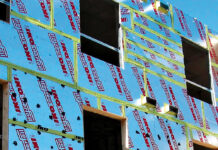By Natasha Rombough, Director of Marketing and Communications, CHBA
If you’ve ever been curious about what the inside of a modular factory looks like, Rick Weste, president and CEO of Triple M Housing Ltd., would be a great tour guide. When he’s not out bow hunting (he’s a national archery champion), hiking or volunteering his time with CHBA, Weste is hard at work at Triple M, which he likes to think the 3 M’s of as standing for Making Modular Mainstream.
Weste started with the company in 1996. From software consultant to sales and marketing, legal and human resources, and overseeing production, he worked his way up and learned how to successfully run a modular factory.
Triple M mainly builds high-quality, single-family homes. The company can also build attached homes, and is currently constructing 14 schools for remote areas in Manitoba. At an average of 3000 sq. ft., the schools are similar in size to a larger single-
family home.
An established company
Triple M has been operating in Lethbridge since 1981, though has gone through a few name changes and sales in that time. In fact, the company was sold to ATCO last year, though Weste says not much has or will change in the day-to-day for those working at Triple M.
There are many long-term employees, including several who have been with the company for more than 40 years. Weste says that people stay because they like their coworkers and the great working conditions. Employment is stable, wages and benefits are competitive, and the hours are good. That employment stability makes modular construction factories desirable employers within the industry.
Another positive is the use of automation and machinery. “When we hire someone, we put them through physical testing because we want to understand what they’re capable of, where their restrictions are, what their capabilities could be, and where they can work,” Weste says. The factory process is set up to minimize stress on the body as much as possible. Construction materials are positioned as though they’re at ground level; a forklift would raise shingles up to the roof, for example, so someone shingling the roof would have easy access to them.
Safety is also a major priority, with a focus on accident prevention measures. For example, scaffolding systems are put in place between the houses so that when several homes are being worked on at one time, workers can walk on the scaffolds between the houses and onto the roofs without risking a fall. The company has held a “Certificate of Recognition” in the Partnership for Injury Reduction program in Alberta since its inception. Triple M is proud that it is currently approaching three years without a lost time accident, and has an excellent total recordable injury rate (TRIR).
These measures can also help make the work more accessible and appealing to those who are not traditionally employed in residential construction. Weste says that approximately 18 per cent of Triple M’s employees are women, which is higher than the estimated Canadian average. The work is still physical – it’s far from a desk job – but it’s more accessible, which has the added benefit of people staying in physical jobs longer.
Modular construction is also a great place for new Canadians to find meaningful work. Immigration will need to play a major role in replacing workers in residential construction as they retire over the next 10 years, and the factory setting can help create the sense of community many immigrants desire. At Triple M, 27 per cent of workers speak English as a second language, and there are currently 25 languages spoken in the factory.
Working with a modular factory
Triple M builds between 500 and 700 homes each year in its more than 190,000-sq.-ft., state-of-the-art facility. In total, the company has constructed more than 28,000 homes. To build that many, efficiencies are key and turnaround times are blazing. “If you order a house from us today, we will take eight weeks to finalize the design and get the materials ordered, and then it takes us two weeks to build the home and have it ready to ship,” Weste says.
The homes arrive fully finished at their destination, and the time it takes to install them depends on site specifics, such as whether the unit is going on a basement, blocking or piles. If the services are ready and it’s a simple installation, the home could be ready to live in within days. If it’s a more complex site and there are several modules that need to come together with connection details, and drywall finishing is required, it may take up to six weeks.
For developers, bringing in modular construction can mean completing your developments much faster with the same number of people, Weste explains. Given the labour shortages in the industry, and Canada’s housing shortage, modular-built construction is one of the solutions our country needs.
Another positive of modular construction is how well they’re built to withstand transportation. Triple M invests in quality materials and products, and construction is done in its climate-controlled factory that is inspected by third party agencies. The strength of its wall systems allows the company to provide an industry-leading 20-year structural warranty. And the building processes makes for tight, energy efficient homes.
Association involvement
Triple M has long been a member of its local association of BILD Lethbridge, and Weste remembers participating in the Home and Garden Show and Parade of Homes as a way to get Triple M’s modular homes in front of the public. He says that people who attended both events were surprised to see the same home in two different locations – first in a parking lot, and then six weeks later on a basement and surrounded by a landscaped lot. “People were going through the home the second time saying they found it really familiar and couldn’t believe it was the same house.”
In addition to being active with BILD Lethbridge, Triple M was also a member of the Canadian Manufactured Housing Institute (CMHI), and Weste served as its president from 2015 to 2017. At the time, CMHI and the Canadian Home Builders’ Association (CHBA) worked closely together on several mutual priorities, and even shared office space. With the goal of support the increasing role of factory-built modular construction in the homebuilding industry, CMHI and MHI Canada joined forces to create the CHBA Modular Construction Council, which still exists today and is as important as ever. Weste served as the Council’s first Chair.
“I planned on being Chair for two years and then fading into the background,” he recalls, shaking his head. Instead, Weste went on to chair CHBA’s Technical Research Committee for three years (a term made longer than usual due to the pandemic), and then was appointed to the CHBA National Board of Directors, a position he currently holds. His extensive involvement at the national level over the years resulted in Weste being awarded the CHBA’s most prestigious accolade of Member of the Year in 2022.
What’s next for Triple M
The company already ships homes into all of western Canada, the Northwest Territories and Nunavut, and as far east as Manitoba, but at the Manitoba-Ontario border things get complicated. Weste would love to bring Triple M to builders in Ontario, but hasn’t yet found a way to make it work due to complicated and expensive transportation.
In the meantime, the company is looking to expand more into purpose-built rentals. “I think there’s going to be a huge change coming in the way that municipalities here in Alberta are going to be approving housing,” Weste predicts. Indeed, many municipalities across the country are getting more creative in their pursuit of creating more housing supply to tackle affordability.
One thing is clear: Our industry needs to increase its productivity in the coming years to help meet Canada’s housing demand, and modular factories such as Triple M are ready to lead the charge.
Fast facts
Company Name: Triple M Housing Ltd.
Head Office: Lethbridge, Alta.
Number of Full-Time Employees: 350
Projects per year: 500-700 homes/year
Coming CHBA Events
Feb. 6, 2024
CHBA Day on the Hill
Ottawa
March 2024
Finalists Announced for CHBA National Awards for Housing Excellence
May 6-10, 2024
CHBA Home Building Week in Canada
Saint John, NB
June 11-12, 2024
CHBA Net Zero Leadership Summit
Vancouver


















